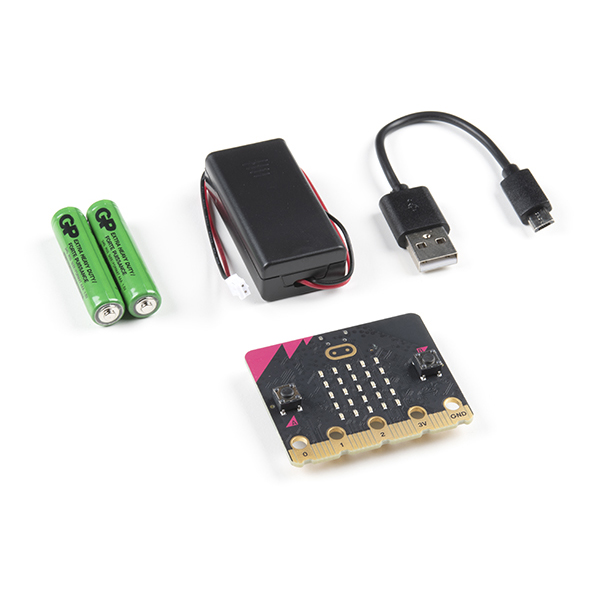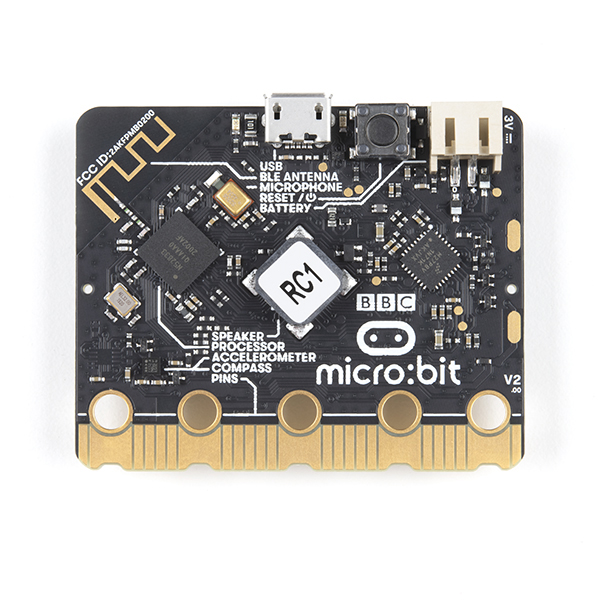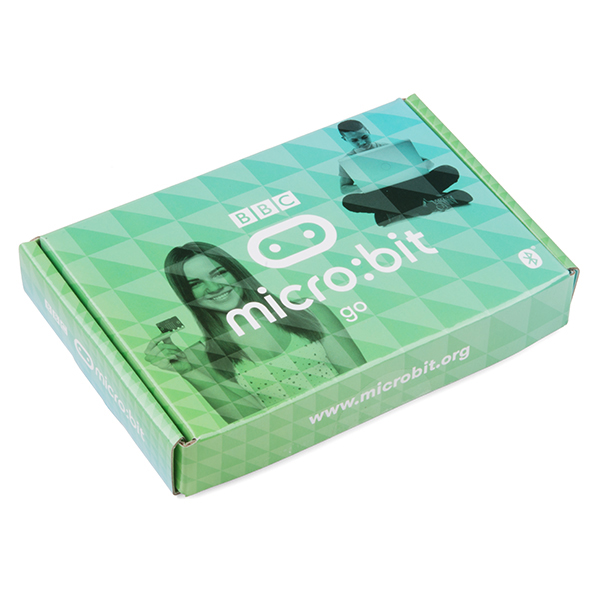The BBC micro:bit v2 is a pocket-sized computer that lets you get creative with digital technology. Each order contains just the micro:bit v2 board. You can code, customize and control your micro:bit from anywhere! You can use your micro:bit for all sorts of unique creations, from robots to musical instruments and more. At half the size of a credit card, you will be surprised at the amount of hardware each board is equipped with, including 25 red LED lights that can flash messages. There are two programmable tactile buttons, and a touch sensative logo that can be used to control games or pause and skip songs on a playlist. The micro:bit can even detect motion and tell you which direction you’re heading. It can also use Bluetooth Low Energy (BLE 5.0) to interact with other devices and the Internet.
This micro:bit v2 Go Bundle provides you with everything you need to get hooked up and powered. This kit includes the micro:bit v2 a short USB cable, a AAA battery holder and AAA batteries. Also inside the Go Bundle you will find a Quick Start Guide with four unique ideas to get you started with micro:bit! The Go Bundle is a quick and economical way to get started with the micro:bit.
On the front of the board you will find the 5x5 LED array that you can use as a light sensor, a tiny screen to draw on, display words, numbers and other information, microphone input & LED indicator, two programmable tactile buttons, and the touch sensitive logo! On the back of the board you will find the brains of the micro:bit, a 64 MHz, ARM Cortex-M4 microcontroller with FPU, 512KB Flash, 128KB RAM and a built-in temperature sensor. Additionally, the back of the micro:bit is populated by an accelerometer, compass, MEMS microphone, speaker, and Bluetooth Smart antenna, as well as a microUSB and two-pin JST connector for different power options. Finally, at the bottom of the board you will find 25 gold-tabbed edge pins and five ring connectors (three for digital/analog I/O, two for power and ground) for hooking up external components. The tabs with larger holes can be easily used with alligator clips are now notched fore easier connection to prototype added components quickly.
The micro:bit has even supplied an intuitive mobile app that lets you send your code to your micro:bit over Bluetooth (without using a USB cable). With this app you will be able to interact with your micro:bit on a higher level of accessibility.
Note: If you are looking to buy the micro:bit v2 Go Bundle is larger quantities, we do offer it in packs of 10 at a reduced price with the micro:bit Club Kit. Make sure to check that kit out instead to save today!
- 1x micro:bit v2 Board
- 1x micro USB Cable --- 6in
- 1x Battery Holder --- 2xAAA
- 2x AAA Batteries
- 64 MHz Arm Cortex-M4 with FPU
- 512KB Flash
- 128KB RAM
- 5x5 Red LED Array
- Two Programmable Buttons, one touch sensitive logo
- MEMS microphone and LED indicator
- Onboard Light, Compass, Accelerometer, Temp Sensors and Speaker
- 2.4 Ghz Micro:bit Radio/BLE 5.0 Smart Antenna
- 25-pin Edge Connector
- 4 dedicated GPIO, PWM, i2c, SPI, and ext. power
- Three Digital/Analog Input/Output Rings
- Two Power Rings --- 3V and GND
- Dedcated I2C bus for peripherals
- MicroUSB Connector (5V)
- JST-PH Battery Connector (Not JST-XH) (3V)
- Power/reset Button with Status LED
- 200 mA available for accessories
- Program with C++, MakeCode, Python, Scratch
micro:bit v2 Go Bundle Product Help and Resources
micro:bit Educator Lab Pack Experiment Guide
May 8, 2018
A quickstart guide for the micro:bit educator lab pack.
SparkFun Inventor's Kit for micro:bit Experiment Guide
July 21, 2017
This guide contains all the information you will need to explore the twelve circuits of the SparkFun Inventors Kit for micro:bit.
Getting Started with the micro:bit
September 2, 2021
The BBC micro:bit is a compact, powerful programming tool that requires no software installation. Read on to learn how to use it YOUR way!
Getting Started with MicroPython and the SparkFun Inventor's Kit for micro:bit
July 11, 2017
Learn MicroPython with the micro:bit.
How to Load MicroPython on a Microcontroller Board
September 4, 2018
This tutorial will show you how to load the MicroPython interpreter onto a variety of development boards.
Core Skill: Programming
If a board needs code or communicates somehow, you're going to need to know how to program or interface with it. The programming skill is all about communication and code.
Skill Level: Rookie - You will need a better fundamental understand of what code is, and how it works. You will be using beginner-level software and development tools like Arduino. You will be dealing directly with code, but numerous examples and libraries are available. Sensors or shields will communicate with serial or TTL.
See all skill levels
Core Skill: Electrical Prototyping
If it requires power, you need to know how much, what all the pins do, and how to hook it up. You may need to reference datasheets, schematics, and know the ins and outs of electronics.
Skill Level: Rookie - You may be required to know a bit more about the component, such as orientation, or how to hook it up, in addition to power requirements. You will need to understand polarized components.
See all skill levels
Comments
Looking for answers to technical questions?
We welcome your comments and suggestions below. However, if you are looking for solutions to technical questions please see our Technical Assistance page.
Customer Reviews
5 out of 5
Based on 2 ratings:
1 of 1 found this helpful:
Lots of fun
The microbit is lots of fun. I’m using it to learn embedded Rust to make various toys for my kids. It’s great!
An Amazing Device!
I've been introducing the Arduino platform on a limited basis to my students for about a year now, but what I've found is that even though there are some beginner-friendly aspects to it, it is not a good first step for everyone. The micro:bit seems to be a much better fit for students who have no experience with hardware and software. I've workshopped it with a few students over the past few weeks, and I'm finding much higher engagement and success, especially among those who have no prior coding experience. I'm currently seeking a grant to provide a class set for next year.





I am an uncle to some smart nieces, what is the recommended age?
We recommend 9-10 years old!